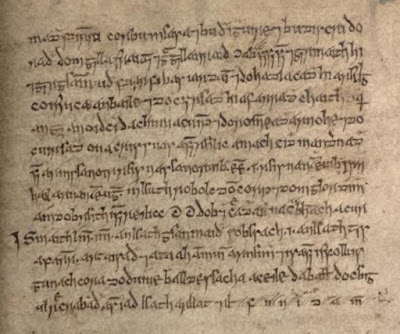Meileann muileann na Gaeilge go mín.
12 Feabhra 2022
08 Feabhra 2022
04 Feabhra 2022
An Bhean Gheanmnaí a Raibh Drochbhéal Uirthi
Fainic! Tá an obair seo idir lámha fós.
An baoite ar dtús, an rud a tharraing m’aire:
Scríobh Edward Gwynn an nóta sin sa bhliain 1905 faoi théacs sa lámhscríbhinn Liber Flavus Fergusiorum. Tá an chéad líne den téacs ar leathanach amháin. Tosaíonn an scéal ansin mar a scriobh Gwynn, ach le focal amháin eile ann: theangadh.Tá an chuid eile den scéal ar an gcéad leathanach eile:
Rinne mé tras-scríobh de, cé nach bhfuil chuile chuid de cinnte:
Vir namque vitae venerabilis Felix, Portuensis episcopus, in Sabinensi provincia ortus atque nutritus est. Qui quamdam sanctimonialem feminam in loco eodem fuisse testatur, quae carnis quidem continentiam habuit, sed linguae procacitatem atque stultiloquium non declinavit. Haec igitur defuncta, atque in ecclesia sepulta est. Eadem autem nocte custos ejusdem ecclesiae per revelationem vidit quia deducta ante sacrum altare per medium secabatur, et pars una illius igne cremabatur, et pars altera intacta remanebat. Cumque hoc surgens mane fratribus narrasset, et locum vellet ostendere in quo fuerat igne consumpta, ipsa flammae combustio ita ante altare in marmoribus apparuit, ac si illic eadem femina igne corporeo fuisset concremata. Qua ex re aperte datur intelligi quia hi quibus peccata dimissa non fuerint, ad evitandum judicium sacris locis post mortem non valeant adjuvari.
Felix, Bishop of Portua, a man of holy life, who was born and brought up in the province of Sabina, saith that there lived in that place a certain Nun, which, though she were chaste of her body, yet had she an ungracious and foolish tongue: which departing this life, was buried in the church: the keeper whereof, the night following, saw her by revelation brought before the holy altar, where she was cut in two pieces, and the one half was burnt in the fire, and the other was not touched at all. Rising up in the morning, he told unto others what a strange vision he had seen, and shewed them the very place in which she was burnt, the marble whereof appeared with the very marks and signs of a fire upon it, as though that woman had been there burnt in very deed with corporal fire. By which we may plainly see, that such as have not their sins pardoned, can reap small benefit by having their bodies after death buried in holy places.








